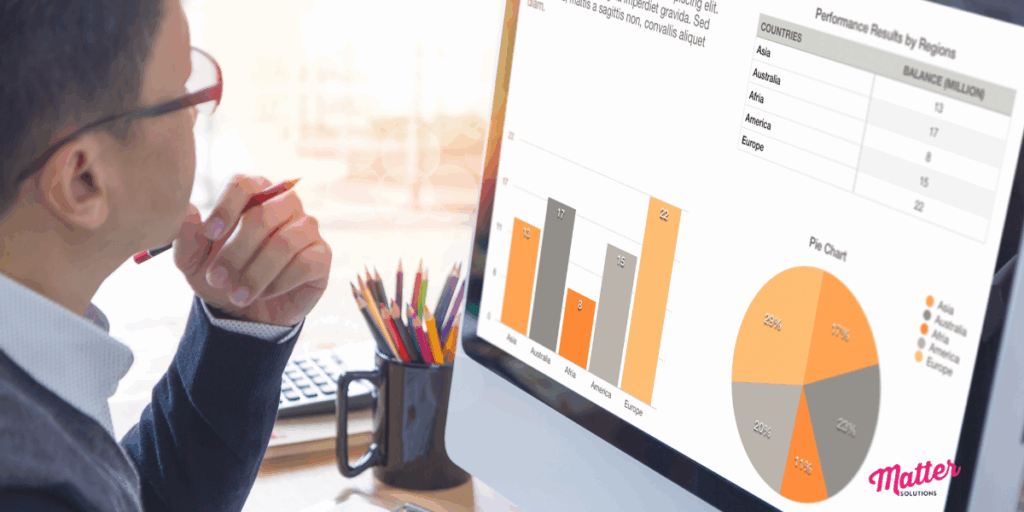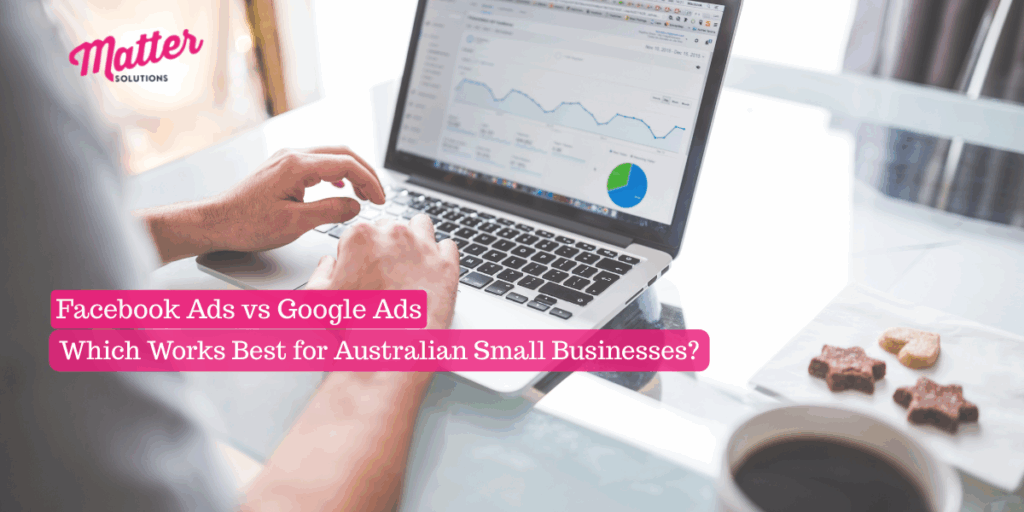Australian small business owners face a common question: where should they invest their limited marketing budget, Google or Facebook? The answer depends entirely on your specific business objectives rather than which platform is ‘better’ in general.
At www.mattersolutions.com.au, we help Australian businesses make profitable platform decisions using data-driven frameworks. So we understand the problems these companies face every day.
In this article, we’ll compare both advertising platform strategies and discuss which platform matches your goals. You’ll also learn about budget considerations for effective campaigns and practical tools to measure actual ad ROI.
Read on to make an informed choice about ad platforms and ensure growth for your business.
Google Ads vs Facebook Ads for Small Business Advertising
Many people choose ad platforms based on what sounds good instead of what works for their business. They end up wasting money. That’s why you must know your goals before picking an advertising platform. This simple step saves Australian small businesses from losing money on the wrong ads.

Let’s see how you can figure out your business goals and budget your ad spend.
Define Your Campaign’s Goals for Best Results
Believe it or not, your campaign goal will decide which advertising system you should use. We’ll give a breakdown below on what we mean by this.
Take Google Ads as our first advertising system. It works great when someone types in ‘Brisbane plumber emergency service’ because they need help instantly. We know it as intent-based advertising, as you can reach people right when they’re searching for a plumber.
What does Facebook Ads do, though? Well, they use audience and interest-based targeting. This platform allows you to choose who to show your ads to instead of relying on searches. For example, you can target homeowners between 35 and 55 who live in older homes that may need repairs.
Now, the advantage of Google Ads is simple: timing. You appear right when someone is ready to hire, which makes it perfect for emergency services. But Facebook Ads work differently. They do well when you want people to recognise and remember your brand when the time comes.
Of course, there are limits. Google only works if people are searching, so you can’t reach those who aren’t looking yet. Meanwhile, Facebook can feel slower because people might not need a plumber today. Still, ad lines like ‘Save Our Number’ will remind others of you when in need.
Deciding on Your Initial Ad Spend Budget
Both Google Ads and Facebook Ads can work with small budgets. You just need different amounts to test them properly.
On average, Google Ads cost around $10 per click in competitive industries. That’s why advertisers usually need a higher daily budget if they want consistent results from Google.
But Facebook Ads cost between $0.50 and $2 per click overall. This lower cost makes Facebook a more affordable option for businesses that want to test campaigns with less money.
Where do you begin with budgeting, then? Many experts suggest starting with $1,500 to $2,500 monthly for meaningful testing on Facebook. And Google often requires $2,000 to $3,000 monthly to compete effectively (yes, it stings a little, but reality isn’t cheap).
Pro-Tip: Be precise about your focus. This is because lead generation needs quick answers, but brand awareness can take weeks to show results. Plan and budget your ads accordingly.
Comparing Platforms for High-Intent Searches
The difference between Google and Facebook comes down to capturing existing demand versus creating new demand. That is, Google catches people who already want to buy something, while Facebook finds people who might buy later.

Time to dig deeper into the difference between Google Ads and Facebook Ads. Keep reading.
The Power of Facebook for Audience Building
One of the best things about Facebook ads is creating interest among the audience. Instead of waiting for people to search, Facebook takes the demand generation approach. They find customers through their interests, demographics, and behaviours.
There’s a catch. This approach creates future demand as opposed to capturing present intent. Sure, Facebook users might not need your services now, but they could easily become customers in six months after seeing your brand multiple times. That’s the bigger picture here.
Ads for Local Service Areas
Local Aussie businesses see different results from each advertising platform, depending on their service type. The main thing here is that you only need to pinpoint how people look for your service in your area. In other words, you need to figure out whether people search on Google or scroll on Facebook.
Here’s how ad platforms work for your Australian local businesses:
- Google for Local Search: Google Ads targets users who are actively searching for services within a specific postcode, like ‘electrician in Bondi’. These people need help right now and will likely call today.
- Facebook for Local Awareness: The Facebook ad platform focuses on homeowners in the same postcode with brand awareness or introductory offers. They may not need an electrician right now, but they could remember your business or save your details for the future.
When to Use a Facebook Advertising Campaign
You’re probably wondering when using Facebook ads is right for you. Honestly, Facebook works best for visual products, lifestyle brands, and businesses that benefit from storytelling.
More specifically, if people need to see your product in action or get a feel for your brand first, Facebook is the better choice. Its visual ads make it easier to show off what you do compared to Google’s text ads (admit it, you’ve clicked a workout before-and-after photo).
A Strategic Choice for Facebook Ads Australia
Your process of making effective decisions about Facebook advertising involves understanding the tools and tactics that deliver measurable results. Unfortunately, we’ve seen that many Australian businesses often miss essential steps that prove Return on Investment (ROI).
What is ROI in ads anyway? It shows how much profit you make compared to what you spend on ads. For example, if you spend $100 on ads and earn $300 back, your ROI is strong. But if you spend $100 and only earn $50, your ROI is negative and the campaign is wasteful.
We’ll look at the practical methods below that will make your campaigns effective.
Choosing Ad Formats to Capture Attention
The visual style of your Facebook ads directly affects how many people stop scrolling to engage with your content. Facebook offers multiple ad formats, each designed for different goals.
Let’s start with video ads. They work best for demonstrating products or services. Meanwhile, carousel ads let you showcase multiple items or tell a story across several images. There’s another type called collection ads, which combine video with product catalogues. This ad format is perfect for e-commerce stores.
Here’s something important. You should choose your ad format based on your main goal. Like, if you need immediate phone calls, simple image ads with clear contact details often outperform fancy video content (people just want the phone number, not a movie).
So, it’s a good idea to test different ad formats with small budgets before committing to costly content production.
Pro-Tip: Refresh your ad creatives every few weeks. Even the best format stops performing once audiences get ‘ad fatigue’, so swapping images, headlines, or copy keeps results strong.
Using the Meta Pixel for Retargeting Data
The Meta Pixel is a small piece of code that tracks visitor behaviour on your website. Once you install it, the code records actions like page visits, product views, and purchases to create audiences you can retarget with relevant ads.
Now, why is Meta Pixel such a powerful tool for Australian businesses? It helps you make ad spend work like a long-term asset. That means you can reach people who already know your brand but have not bought yet, instead of always chasing new customers.
Optimise Your Google Business Profile First
Before spending money on any paid advertising, optimise your free Google Business Profile (GBP). That’s because when people click your Facebook or Google ads, they often check your business profile before calling or visiting.
From our experience, a complete GBP with current hours, photos, and positive reviews boosts trust for all your marketing efforts. Don’t miss out on its fruits!
Making the Right Choice for Your Business
Let’s recap. Google Ads and Facebook Ads work differently. The first one captures existing demand, while the second one generates new demand. This fundamental difference should influence your every decision about where to invest your marketing budget.
In this article, we’ve explored how to define your campaign goals to match the ad platform’s strengths. You’ve also learned how each platform serves different customer journey stages.
Ready to make your advertising spend work effectively for your business? Contact our experts at Matter Solutions for a strategic consultation. Get rid of your confusion about ad platforms today and start running campaigns that attract the right customers without draining your budget.

